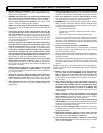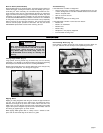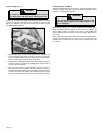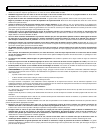
page 9
Troubleshooting
If the blade does not follow a straight line:
• Teeth are dull. This is caused by hitting a hard object such as a nail
or stone, dulling teeth on one side. The blade tends to cut to the side
with the sharpest teeth.
• Shoe is out of line or bent
• Blade is bent
• Rip fence or guide are not being used
If the blade binds, smokes or turns blue from friction:
• Blade is dull
• Blade is on backwards
• Blade is bent
• Blade is dirty
• Workpiece is not properly supported
• Incorrect blade is being used
Electric Brake (Select Models)
Select models feature an electronic brake. The brake engages when you
release the trigger, causing the blade to stop and allowing you to pro-
ceed with your work. Generally, the saw blade stops within two sec-
onds. However, there may be a delay between the time you release the
trigger and when the brake engages. Occasionally the brake may miss
completely, If the brake misses frequently, the saw needs servicing by
an authorized MILWAUKEE service station. The brake is not a substitute
for the guard, so you must always wait for the blade to stop completely
before removing the saw from the workpiece. The correct brush grade
must be used for proper operation of the brake. Use only the correct
MILWAUKEE replacement brushes when servicing the tool.
Cutting Large Panels (Fig. 9)
Large panels and long boards sag or bend if they are not correctly
supported. If you attempt to cut without leveling and properly supporting
the workpiece, the blade will tend to bind, causing KICKBACK.
Support large panels. Be sure to set the depth of the cut so that you only
cut through the workpiece, not through the supports.
APPLICATIONSAPPLICATIONSAPPLICATIONS
WARNING!
Dust, chips and grit can cause the guard to hang
up at any time. If the saw is used with an abrasive
cutting wheel, reserve and mark it for that use
only. Before using it for wood cutting, return it to
a MILWAUKEE service facility for cleaning and
testing.
Fig. 9
Ripping Wood
Ripping is cutting lengthwise with the grain. Select the proper blade for
your job. Use a rip fence for rips 4" wide or less. To install the rip fence,
slide the bar through the rip fence slot in either side of the shoe. The
width of the cut is the distance from the inside of the blade to the inside
edge of the rip fence. Adjust the rip fence for the desired width, and lock
the setting by tightening the rip fence screws.
When ripping widths greater than 4", clamp or tack 1" lumber to work-
piece and use the inside edge of the shoe as a guide.
Cross-Cutting Wood (Fig. 10)
Cross-cutting is cutting across the grain. Select the proper blade for
your job. Advance the saw slowly to avoid splintering the wood.
Fig. 10


















